
Vol. XIX, No. 8, September 2019
- Editor's corner
- Changes to community-based entertainment & arts spending
- Our CEO's presentations
- The upended CLV business model: it's no longer about the entertainment attractions
- Best designed restrooms for 2019
- Family time has taken a new meaning
- VR the next big thing, but not where you think
- The scoop on live events and festivals
The upended CLV business model: it's no longer about the entertainment attractions
Around two decades ago at the beginning of the 21st Century, it was a completely different world for the appeal of out-of-home (OOH) entertainment and attractions. There were far fewer OOH options, including types of attractions, games and venues. And the foodie culture hadn't yet emerged.
Back then we were still years away from the introduction of smartphones, and the only option for home delivery of meals was pizza, and maybe Chinese. But probably the biggest difference is we had far fewer at-home digital and screen-based entertainment options. The internet was still young and home connections speeds were just a crawl over dial-up. Facebook and other social media sites didn't exist. There was no streaming video to any extent. Netflix was only a mail delivery DVD service. Massively multiplayer online role-play video games (MMORPG) didn't exist in that era of the 8-bit Game Boy, and eSports didn't exist, let alone recognized as an Olympic sport. In just nearly two decades since, new technologies have changed how we live, work, shop and especially how we play.
Today, the OOH leisure and entertainment options we have, especially in our local communities, have mushroomed. In addition to all types of new attractions such as escape rooms, axe throwing, the number of CLVs of all types, including new school concepts such as Topgolf and Punch Bowl Social, and the number of live, one- and limited-time events, including all different types of festivals, have proliferated in just about every market.
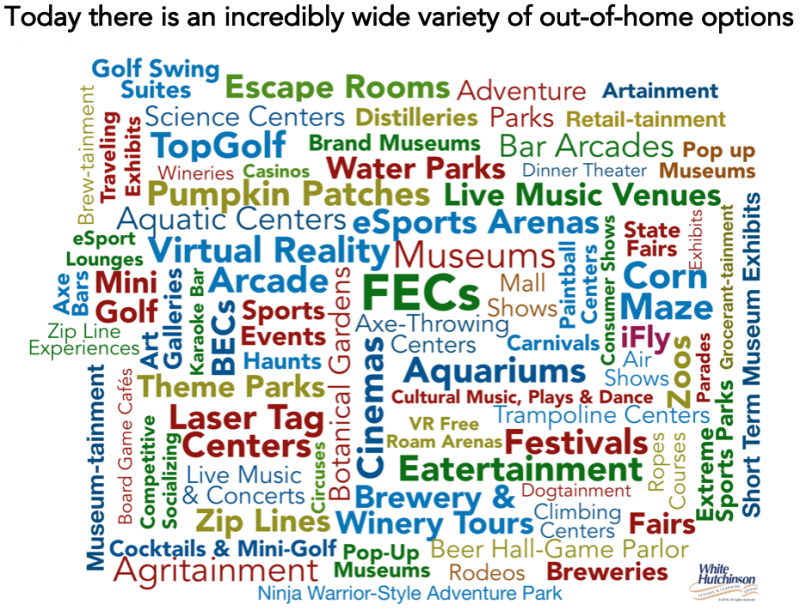
Basically, both the OOH and at-home competitive landscape that existed back in 2000 is now dwarfed by all the options we have today for our leisure time.
The difference between back then and today has resulted in a basic change to the culture and appeal of OOH entertainment and attractions. Back then it was all about the attractions. They alone had sufficient appeal to motivate people to leave their limited options at home. Back then cabin fever was real, and we had a real need to get out of our homes to find something to do.
Today, consumers' at-home and screen-based information, communication and entertainment technology options have exploded. We now have streaming movies and video, binging on a video series, high-resolution, internet-connected MMORPG games, all forms of social media, technologies like texting and Facetime to socialize with our friends and home delivery of meals from just about any restaurant. Additionally, the outside world has become scarier with terrorism and random shootings. We have moved from cocooning at home to as Faith Popcorn has now labeled, “bunkering” at home. Our cabins have become our fear-free, modern oases where we can totally retreat from the outside world and enjoy all variety of entertainment and digital socialization. Staying home has become the new “going out.”
Several other things have changed from back in 2000 that are dramatically impacting the culture of OOH leisure and entertainment. One is time famine. Today, there are so many more things we want to do, and it seems like so little time to do them. In reality, our leisure time today is the same as it was back then, plus or minus a few minutes each year. However, it is more fragmented, broken into smaller time periods. And as a result of now having far more options of what we want to do in our leisure time, especially feed by all the information and FOMO on social media, we feel time pressed as we now want to fit more in than we did back in 2000. Time has become the new currency.
Another major change is that we have moved from conspicuous consumption of stuff to conspicuous leisure. Two decades ago, you gained much of your status based on displaying the stuff you owned, whether your house, your car, your logoed clothes, purse or watch, etc. Today we have shifted into the experience economy where you gain status by the things you do, especially the leisure activities. And this has been magnified in importance by social media. Now we can, at the very moment we are having some leisure or entertainment experience, share it online to gain the envy of our followers and build our social capital. In fact, if it isn't worth sharing on social media, if it isn't Instagrammable, it probably isn't worth doing. Today we are interested in doing as many different share-worthy OOH experiences as possible to add to our experiential CVs.
As a result of all these changes, entertainment attractions have a much shorter life cycle today. In the past, people might have repeated the attraction experience multiple times; today most people just move on to all the other options they haven't experienced. What is known in psychology as “hedonic adaptation” - with each visit the emotional appeal of an attraction diminishes - occurs more rapidly today. Whereas in the past something new might have lasted three or more years until its appeal started a decline, today it might only last for a year or two. Attractions, even some venue concepts, now experience accelerated obsolescence.
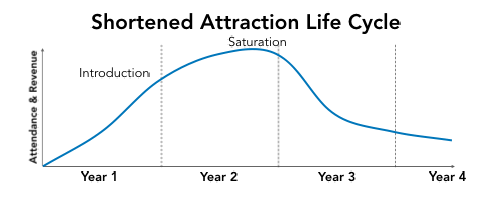
In the past, most community leisure venues (CLVs), and especially family entertainment centers (FECs), only had to introduce some new attraction every three years or so to stay relevant. They would always be on the search for the next “big thing” that would fill that need. Today, with the accelerated obsolescence of attractions for repeat appeal, CLVs are on a fast moving treadmill where the next big thing can't come fast enough. Additionally, needing to invest in new attractions more frequently totally upends their economic business model.
We now live in the foodie-era of adventure and discovery where dining and drinking out is considered a fun, social experience, even qualifying as a form of entertainment by a large segment of the population. Dining out is now an entertainment attraction, often with more appeal than traditional entertainment venues. Food and drink is top-of-mind, a passion, a hobby for the majority of 20- and 30-somethings who self-identify as foodies. Even older adults are looking to experience new and unique dining experiences. The mediocre food that CLVs, and especially FECs, offered just a few years ago no longer cuts it in today's world. Today consumers are making their destination decisions for just about every type of OOH experience based on the quality and variety of its food and craft drink offerings.
There's one more significant dynamic that has impacted OOH entertainment and leisure. It has become gentrified, basically due to the loss of the middle class and the availability of all the inexpensive digital entertainment options (think in terms of cost per hour to use) the lower socioeconomic with their limited discretionary spending now have to fill their entertainment needs. They can avoid leaving home for more expensive OOH entertainment. The lion's share of the OOH community-based entertainment market are bachelor's and higher degreed households who have grown from 47% back in 2000 to currently 71% of all OOH community entertainment and arts spending.
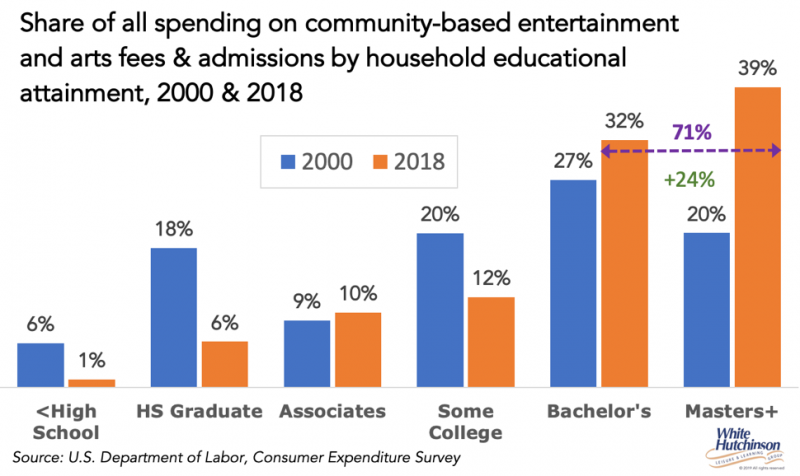
Compared to as recently as 2012, bachelor+ adults age 25+ have grown to account for 42% of all OOH time spent at entertainment and art venues to 52% in 2018. CLVs now need to cater to guests with more sophisticated values, tastes, preferences and expectations. These highly educated adults have the least leisure time compared to lesser-educated households.
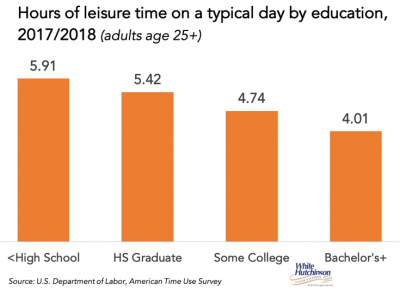
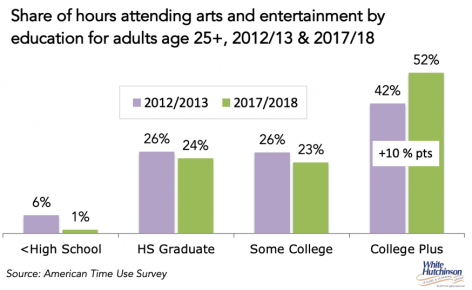
Higher educated adults' scarcity of free time and feelings of time famine makes the choice of how they spend that time even more important to them. They want to fill what free time they do have with the highest quality, life-enriching and memorable experiences. And they are willing to pay a higher price for those quality experiences that make the best use of their more valuable leisure time. For them, time is the currency they have to invest in OOH experiences.
As a consequence of all these changes over what is historically a very short time period, the consumer, their preferences, expectations, values and behaviors have resulted in a seismic change to the culture of leisure and entertainment. Today it is completely different than it was back in 2000. As a result, the legacy business model for CLVs, and especially FECs, that worked based on repeat appeal of entertainment attractions, has been totally upended and no longer works in today's world. It is broken - been there, done that, let's move on to all the other new and unique experiences we haven't done that can be shared on social media and can build our social capital. Those venues still practicing that legacy business model based on anchor entertainment attractions have been totally disrupted as they have lost their repeat appeal and are now on a slow death spiral.
Our company recently analyzed the attendance records of 16 different community entertainment centers that all opened within the last 3 to 4 years, including family entertainment centers (FECs), centers with what are considered time-proven, classic entertainment attractions and located in different markets of all sizes, from mid-size cities to large metropolitan areas. Many were located in dense higher socioeconomic markets. All the centers had continually declining attendance. When we dug into the data, we found that the primary reason was a lack of repeat appeal. On average, customers were only attending 1.1. to 1.3 times a year. What was happening was there was a small hard-core group of repeat customers, who you might call “fans,” but most customers had only come once since the centers opened. They'd been there, done it, and moved on to all the other options. So eventually the available supply of first time (and only one-time) customers becomes depleted in that market. When we plotted the attendance on a graph, the attendances were all a downward slopping line with attendance declines over the lives of the centers of anywhere from 25% to 54%.
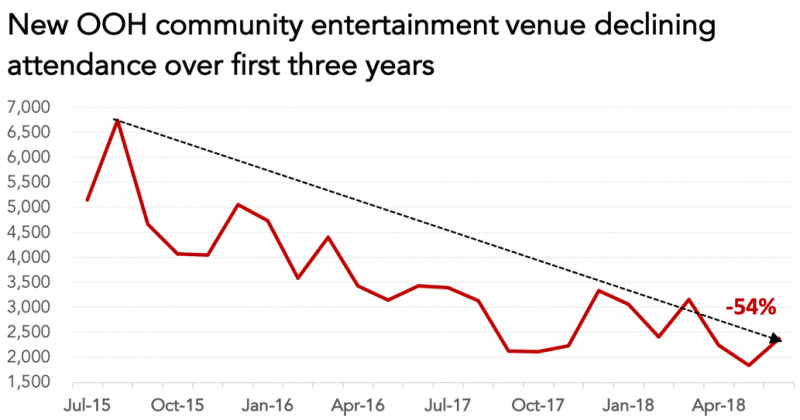
The new successful long-term business model for OOH entertainment is completely different today. The entertainment attractions, and especially participatory social games, are still an important part of the mix, but they have actually moved from being the anchors into a lesser role. Destination-worthy, foodie-worthy food and drink combined with an appealing adult social atmosphere and ambiance have now become critical anchor components for most future-proof CLVs. Being a social destination, where the socialization is activated and facilitated by the games, food and drink, the guest hospitality services and the overall design is now key. But even more important in today's OOH entertainment leisure culture is on-going, continually changing programming of live, one- and limited-time events of all types. This also includes LTOs (limited-time offerings) for the food and drink. And rather than just traditional entertainment, there needs to be some transformational experiences. There needs to be changing reasons to return for new, different and unique experiences in order to drive repeat appeal and maintain and grow attendance and revenues.
Our company is pleased to be at the forefront of researching and identifying these and other trends impacting today's, as well as tomorrow's, entertainment culture. We take seriously the need to develop projects for our clients that can compete in the future, not just in the present. That is why we make such a large investment in trends research that we can apply to the design and production of future-proof projects for our clients.
Vol. XIX, No. 8, September 2019
- Editor's corner
- Changes to community-based entertainment & arts spending
- Our CEO's presentations
- The upended CLV business model: it's no longer about the entertainment attractions
- Best designed restrooms for 2019
- Family time has taken a new meaning
- VR the next big thing, but not where you think
- The scoop on live events and festivals


